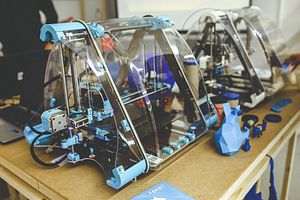Editor’s Note: This is the first in a two-part series by Robert Farley on 3D printing and global security.
A recent RAND study by Trevor Smith, Troy D. Johnson, and J. Luke Irwin explored how the diffusion of 3D printing could disrupt the global economic and security order. The report, based on a panel discussion and survey of a panel of economic and security experts, suggested that Additive Manufacturing (AM) could become widespread enough to radically change existing security arrangements and economic relationships. The core claims are worth evaluating in context of the economy of the Indo-Pacific.
Manufacturing
As the report suggests, “in traditional manufacturing, the cost of production increases based on how complicated an object’s shape is. On an AM printer, costs are roughly the same for producing complex objects and simple ones. Fabricating an ornate and complicated shape does not require more time, skill, or cost than printing a simple block, once the digital design is completed. Industry participants refer to this as getting “complexity for free.”
Essentially, 3D printing offers the chance for a shortcut through the demands of an advanced manufacturing economy. By reducing the need for specialized machinery, and the technological ecosystem necessary to support that machinery, AM reduces the need for skilled human capital at the local industrial level. The basic implication is that we can expect that 3D printing will hasten the decline of skilled employment in certain parts of the manufacturing sector.
Transport
But the question of whether 3D printing will disrupt the transport sector depends on returns to scale: if large manufacturing complexes can achieve economies of scale (whether through acquisition of materials, administrative skill, management of technical details, or whatever else) that allow them to produce for a cost at which transport of finished goods is still viable. Notwithstanding the reduced need for local skilled manufacturing labor, local producers may still find themselves at a disadvantage to large global producers, especially if the latter can take advantage of robust logistical networks.
However, resource demands (both in terms of energy and of the raw materials necessary for manufacturing) will remain significant no matter where production happens. The localized need for manufactured goods will not necessarily correspond exactly with the provision of energy or raw materials, meaning that the globalized trade network will remain, at least for those materials. And again, the ability of large firms to manage and internalize the acquisition of reliable supplies of energy and raw materials may exceed any gains provided by localized production. In short, just because it will become easier to produce finished goods locally does not mean that local producers will benefit, because it will *also* become easier for globalized firms to produce finished goods.
Security
The report notes that AM has the potential to free downstream military consumers (developing countries and terrorist groups, for example) from their dependence upon established producers of sophisticated military equipment. We have already seen Poland, for example, use 3D printing to circumvent its dependence upon Russia for spare parts to maintain its legacy MiG-29 fleet; Iran could easily use the same means to recapitalize its F-14 squadrons. Breaking (or at least damaging) the link between arms transfers and arms maintenance would be a boon for middle-tier arms consumers, and might change the way in which first-tier arms producers think about exports. The United States in particular may find export controls a less useful way of preventing the diffusion of certain kinds of military technologies. Moreover, AM may give non-state actors greater access to capable conventional weaponry than they have previously enjoyed.
That said, it’s not hard to overestimate the potential impact of AM on the spread of military technology. Useful military tech is not atomistic, but relies on a technological and human ecosystem for its utility; it take more than a few spare parts to maintain an F-14 as an effective military platform. AM may change the distribution of effort, but sophisticated weapons will still require complex organizational efforts for maintenance and effective use.
The next installment in this two-part series will address the legal implications arising from these technologies, the trade implications, and implications for the Indo-Pacific region.

































